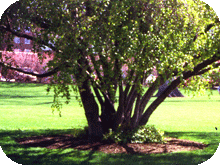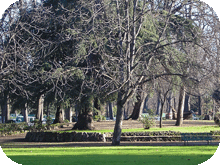
This mailer has been provided as an avenue to disperse information pertinent to public agencies and the landscape architecture profession in hopes of fostering greater understanding and collaboration. Topics address issues that affect the built environment within which we live.
Trees vs. Turf Grasses
"Though a tree grows so high, the falling leaves return to the root."(Malay Proverb)
Contrary to common belief, trees and turf grass are not a completely harmonious combination. In fact, in urban environments, they consistently compete and fight for limited available resources. The following summary will dissect this often misunderstood marriage into two categories: Why trees and turf struggle to co-exist and methods for managing an equilibrium between the two.
Why Trees & Turf Grasses Struggle to Co-Exist
Trees and grasses are two very different plant types which, in nature, tend to grow in exclusive environments consisting of similar plant types (i.e. grasslands, prairies and forests). Typical urban landscapes tend to be an unnatural setting within which these two plant types are combined and then expected to perform just as they do in their natural settings. Below are twelve (12) reasons why this is an unrealistic expectation:
- Tree Root Zone: Tree roots are usually found within the upper 2-3 feet of soil, however the majority of fibrous roots that obtain water and nutrients from the soil are located within the top 6" of soil. Grass species happen to share this same 6" of soil where most of the nutrients and water are stored.
- Root Growth: Grass species have extensive root systems within the upper 6" of soil and tend to respond more quickly and colonize more rapidly than tree roots can.
- Nutrient Use: Studies have shown that grass species will utilize most of the available nitrogen applied to the soil, leaving little for tree growth.
- Limited Soil Moisture: Both trees and turf grasses require large amounts of water and end up competing for the same available soil moisture.
- Air Circulation: Trees reduce air circulation in and around turf grasses increasing humidity and conditions favorable for turf diseases.
- Reduction of Sunlight: Trees significantly impact the quantity and duration of light available for healthy turf grass growth. Some species of trees create more shade and have larger canopies than others.
- Quality of Sunlight: The leaves within a tree canopy absorb the violet/blue and orange/red light wavelengths leaving the green/yellow light wavelengths behind. This effectively leaves the grass without the most photosynthetically active wavelengths that are so important for turf growth. This results in focused growth of leaf blades with little root growth.
- Allelopathy: In contrast to competition for available resources, some plants actually release chemicals (through the soil, air, or through leaf drop) that inhibit the growth or germination of other plant species. One example of a plant that competes in this fashion is the walnut tree.
- Slowing of Germination and Development : Turf grasses have been shown to inhibit the growth of seedlings and young trees when compared to trees not surrounded by turf. This occurs not only due to competition but also because of chemical suppression.
- Differing Water Requirements: Turf grasses and trees both need large amounts of water, however, the rates of application are very different. Turf grasses are irrigated more frequently than trees need to or should be. This results in shallow tree roots which cannot reach deeper water resources, may not be structurally sound enough to support the tree canopy and are often damaged by maintenance vehicles, opening the door for disease and infestations.
- Mechanical Damage: In addition to root damage from mechanical equipment, when grass is located near trees, the trunks quite often are injured with mowers and string trimmers. Severe damage to the cambium layer just below the bark can cause long-term health issues and even death.
- Herbicides: Turf grasses are often sprayed with broadleaf herbicides to discourage the growth of weedy plant species. Overspray of these herbicides can adversely affect and even kill a tree.
Methods for Managing an Equilibrium Between Trees & Turf Grasses
Despite the fact that these two plant types are so different and compete fiercely for the same resources, they can both be incorporated into our urban landscapes effectively. The key is to make their urban environments resemble their natural environments a little more closely.
- Landscape Design: If possible the landscape should be designed from the beginning with thought given specifically to appropriate sun loving or shade tolerant grass species, trees with open/airy canopies, shade patterns caused by the trees, locations of trees in relation to open turf grass areas, proximity of turf grass to dripline of trees and distance between trees. The design should attempt to create as many exclusive environments as possible, minimizing overlap of conflicting plant types.
- Long-term Maintenance: The key to long-term maintenance, limiting the conflict between trees and turf, is to mulch around the trees. Ideally a 12-15 foot radius around the trunk or the entire dripline area should be mulched. This minimizes the amount of turf under the canopy of the tree and any of the issues that come along with turf grass competition.
- Plant Health Care Programs (PHC) : The idea of a comprehensive plant health care program rather than just a maintenance program is based on maintaining the landscape as a whole for the benefit of each of its parts. In essence the maintenance of the landscape should focus on eliminating conflicts between plant types. Mulching under trees, limiting turf areas to active recreation locations and adjusting timing and extent of chemical use are all examples of items that may be included in a PHC program.
References: Lily, Sharon. "Trees vs. Turf." Plant Health Care. 2003. 1-6.
Ham, Donald L, James R. Clark. "Maintaining Tree and Turf Associations." Plant Health Care. 2003. 9-12
The next time you need a Landscape Architect on your project, consider O'Dell Engineering's Landscape Architecture Department.
Services include:
- Park and Playground Design
- Recreational Facility Design
- Site Planning
- Streetscape Design
- Urban Design
- Commercial Design
- 3-D Visualizations
- Graphic Design
- Arborist Consulting
![]()
![]()



Author: Chad Kennedy, Landscape Architect
This informational article provided by O'Dell Engineering - 1165 Scenic Drive, Suite A, Modesto CA 95350
